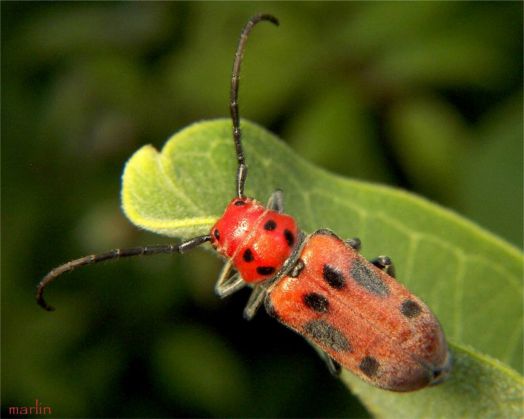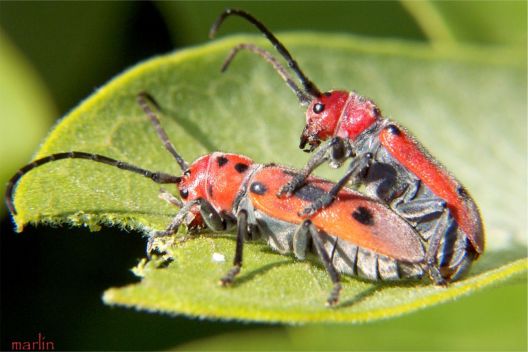 |
Return to Texas Entomology - Compiled by Mike Quinn
cf: T. femoratus, T. melanurus, North American Tetraopes spp.
 |
Host specific to Common Milkweed - Asclepias syriaca
 |
Range: Central and Eastern North America
Adult Activity: Coincides with hostplant flowering, May-September
Hosts:
With few confirmed exceptions, individual Tetraopes species or their subspecies are affiliated with single, differing species of milkweeds in the genus Asclepias - Asclepiadaceae (Farrell & Mitter, 1998). Larvae bore in stems or roots of their host while adults consume the foliage and flowers. Larval root feeding is unique to Tetraopes in the subfamily Lamiinae.
Biology:
The more primitive Tetraopes species, affiliated with apparently less toxic hostplants, have much less surface area brightly-colored (Chemsak, 1963), are smaller in body size on average, and are also more difficult to capture.
Similar Species:
There are 26 species of Tetraopes distributed from Guatemala to Canada, and are most diverse in the Sonoran region.
Thirteen species occur in The United States. (Arnett et al, 2002)Texas Taxa: Per Monné & Hovore (2005)
Milkweed Beetle Species - Asclepias Host Plant Species (per: Farrell & Mitter 1998, Yanega 1996)
Tetraopes annulatus LeConte - A. subverticillata (A. sullivantii (MO) and A. speciosa (AZ))
Tetraopes discoideus LeConte - A. subverticillata (A. curassavica in Mexico to El Salvador)
Tetraopes femoratus LeConte - A. speciosa
Tetraopes linsleyi Chemsak - A. linaria
Tetraopes mandibularis Chemsak - A. latifolia
Tetraopes pilosus Chemsak - A. arenaria, A. tuberosa
Tetraopes quinquemaculatus Haldeman - A. amplexicaulis, A. hirtella
Tetraopes texanus Horn - A. viridiflora
Tetraopes thermophilus Chevrolat - ?
Weblinks:
Tetraopes melanurus - Eastern U.S. - Florida State Collection of Arthropods
Photo: Tetraopes tetraophthalmus - PBase
Type Specimens:
The Museum of Comparative Zoology (MCZ) Type Database at Harvard University
Beetle Species - Range (per: Monné & Hovore, 2002, Yanega 1996)
Tetraopes annulatus LeConte, 1847 - Canada (Alberta)-sw USA (TX, AZ)
Tetraopes basalis LeConte, 1852 - California
Tetraopes discoideus LeConte, 1858 - Colorado to e. Kansas, Arizona to Texas, Mexico, south to Honduras
Tetraopes femoratus LeConte, 1847 - ec USA (OH)-western North America, northern Mexico (widely distributed)
Tetraopes quinquimaculatus Haldeman, 1847 - Eastern North America-Texas
Tetraopes texana Horn, 1878 - Missouri, Oklahoma, Texas, n Mexico
Cerambycidae Holotypes of the Smithsonian Institution
Tetraopes mandibularis - Oklahoma, Texas
Taxonomy:
tetrophthalmus (Forster, 1771)
tetraophthalmus Provancher, 1877 - (Syn)
Arnett, R.H., Jr., M.C. Thomas, P.E. Skelley & J.H. Frank. (editors). 2002. American Beetles, Volume II: Polyphaga: Scarabaeoidea through Curculionoidea. CRC Press. 861 pp.
Chemsak, J.A. 1963. Taxonomy and bionomics of the genus Tetraopes (Cerambycidae: Coleoptera). University of California Publications in Entomology 30(1): 1-90.
Craighead F.C. 1923. North American cerambycid larvae. Dominion of Canada Department of Agriculture Bulletin. 27(New Series–Technical): 1–239.
Davis, M.A. 1984. The flight and migration ecology of the red milkweed beetle (Tetraopes tetraophthalmus). Ecology 64:230-234.
Davis, M.A. 1981. The flight capacities of dispersing milkweed beetles, Tetraopes tetraophthalmus. Annals of the Entomological Society of America 74:385-386.
Davis, M.A. 1980. Variation in flight duration among individual Tetraopes beetles: Implications for studies of insect flight. Journal of Insect Physiology 26:403-406.
Davis, M.A. 1980. Seasonal variation in the vagility of populations of the Red Milkweed Beetle, Tetraopes tetraophthalmus. Environmental Entomology 9:432-435.
Farrell, B.D. 1991. Phylogenetics of insect/plant interactions: Tetraopes and Asclepias. Ph.D. Dissertation. Univ. Maryland.
Farrell, B.D., 2001. Evolutionary Assembly of the Milkweed Fauna: Cytochrome Oxidase I and the Age of Tetraopes Beetles. Molecular Phylogenetics and Evolution 18(3): 467–478.
Farrell, B.D., & C. Mitter. 1998. The timing of insect/plant diversification: might Tetraopes (Coleoptera: Cerambycidae) and Asclepias (Asclepiadaceae) have co-evolved? Biological Journal of the Linnean Society, 63: 553–577. With 6 figures
Gardiner, L.M. 1961. A note on oviposition and larval habits of the milkweed beetle, Tetraopes tetrophthalmus Forst. (Coleoptera: Cerambycidae). Can. Entomol. 93: 678.
Hanley, G.A. 2005. Cerambycidae of North Dakota. Minot State University. 105 pp.
Hartman F. 1977. The Ecology and Coevolution of Common Milkweed (Asclepias syriaca: Asclepidaceae) and Milkweed Beetles (Tetraopes tetrophthalmus: Cerambycidae). Ph.D. Thesis. University of Michigan.
Hovore, F.T., R.L. Penrose & R.W. Neck. 1987. The Cerambycidae, or longhorned beetles, of southern Texas: a faunal survey (Coleoptera). Proceedings of the California Academy of Sciences, 44(13): 283-334, 20 figs.
Lawrence, W.S. 1982. Sexual dimorphism in between and within patch movements of a monophagous insect: Tetraopes (Coleoptera: Cerambycidae). Oecologia 53: 245-250.
Linsley E.G. & Chemsak J.A. 1995. Cerambycidae of North America. Part VII, No. 2. Taxonomy and Classification of the Subfamily Lamiinae, Tribes Acanthocinini through Hemilophini. University of California publications in Entomology, 114: 1-292.
McCauley, D.E. & E.C. Lawson. 1986. Mating reduces predation on male milkweed beetles. Am. Nat. 127: 112–17.
Monné, M.A. & F.T. Hovore. 2005. Electronic Checklist of the Cerambycidae of the Western Hemisphere. 393 pp.
Nishio, S., Blum, M.S., Takahashi, S. 1983. Intraplant distribution of cardenolides in Asclepias humistrata (Asclepiadaceae), with additional notes on their fates in Tetraopes melanurus (Coleoptera: Cerambycidae) and Rhyssomatus lineaticollis (Coleoptera: Curculionidae). Memoirs of the College of Agriculture, Kyoto University 122: 43-52.
Price, P.W. & M.F. Willson. 1979. Abundance of herbivores on six milkweed species in Illinois. American Midland Naturalist 101: 76-86.
Rice, M.E., R.H. Turnbow, & R.T. Hovore. 1985. Biological and distributional observations on Cerambycidae from the southwestern United States (Coleoptera). Coleopterists Bulletin 39: 18-24.
Schieffer, T.L. 1998. Disjunct distribution of Cerambycidae (Coleoptera) in the Black Belt Prairie and Jackson Prairie in Mississippi and Alabama. The Coleopterists Bulletin, 52(3): 278-284.
White, R.E. 1983. A Field Guide to the Beetles of North America. Houghton Mifflin Company, Boston. 368 pp.
Yanega, D. 1996. Field guide to northeastern longhorn beetles (Coleoptera: Cerambycidae). Illinois Natural History Survey, Champaign, 6:1-184.
01 Dec 2008 © Mike Quinn / Texas Entomology / Texas Beetles / Texas Beetle Photos /